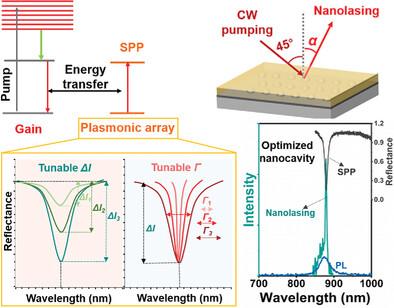A CW-Pumped Dye Nanolaser With an Optimized Nanocavity
IF 13
2区 材料科学
Q1 CHEMISTRY, MULTIDISCIPLINARY
引用次数: 0
Abstract
Plasmonic nanolasers, which are promising coherent light sources for integrated photonics, super-resolution imaging, and ultrasensitive sensing applications, face the challenge of high thresholds due to inherent losses in plasmonic nanocavities. While considerable efforts have been made to improve the Q factor, typically quantified by the full width at half maximum (FWHM), intensity (ΔI) is another critical feature of plasmonic resonance. However, the combined influence of both the Q factor and resonance intensity of a plasmonic nanocavity on nanolasing threshold has not been sufficiently explored, as experimentally controlling one variable while keeping the other constant is challenging. Here, an ultra-low threshold plasmonic nanolaser is demonstrated by systematically optimizing the plasmonic nanocavity. By carefully controlling both the FWHMs and resonance intensities of the plasmonic resonators, a record low threshold of 2.6 µJ cm−2 for a dye-based nanolaser is achieved at room temperature– an order of magnitude lower than previous records. In addition, nanolasing under continuous-wave (CW) excitation is reported at room temperature gained by the same dye molecule. The results provide new insights into the design of high-performance plasmonic nanolasers and offer a promising path toward realizing applications of nanoscale coherent light sources.

具有优化纳米腔的连续波泵送染料纳米激光器
等离子体纳米激光器是很有前途的相干光源,可用于集成光子学、超分辨率成像和超灵敏传感应用,但由于等离子体纳米腔的固有损耗,它面临着高阈值的挑战。虽然人们在提高 Q 因子(通常以半最大值全宽(FWHM)量化)方面做出了巨大努力,但强度(ΔI)是质子共振的另一个关键特征。然而,由于在实验中控制一个变量的同时保持另一个变量不变的难度很大,因此还没有充分探讨质子纳米腔的 Q 因子和共振频率对纳米激光阈值的综合影响。本文通过系统优化等离子纳米腔体,展示了一种超低阈值的等离子纳米激光器。通过仔细控制等离子体谐振器的全宽半径和共振频率,在室温下实现了染料纳米激光器 2.6 µJ cm-2 的创纪录低阈值,比之前的记录低了一个数量级。此外,还报告了在室温条件下,同一染料分子在连续波(CW)激励下获得的纳米激光。这些结果为高性能等离子纳米激光器的设计提供了新的见解,并为实现纳米级相干光源的应用提供了一条充满希望的道路。
本文章由计算机程序翻译,如有差异,请以英文原文为准。
求助全文
约1分钟内获得全文
求助全文
来源期刊

Small
工程技术-材料科学:综合
CiteScore
17.70
自引率
3.80%
发文量
1830
审稿时长
2.1 months
期刊介绍:
Small serves as an exceptional platform for both experimental and theoretical studies in fundamental and applied interdisciplinary research at the nano- and microscale. The journal offers a compelling mix of peer-reviewed Research Articles, Reviews, Perspectives, and Comments.
With a remarkable 2022 Journal Impact Factor of 13.3 (Journal Citation Reports from Clarivate Analytics, 2023), Small remains among the top multidisciplinary journals, covering a wide range of topics at the interface of materials science, chemistry, physics, engineering, medicine, and biology.
Small's readership includes biochemists, biologists, biomedical scientists, chemists, engineers, information technologists, materials scientists, physicists, and theoreticians alike.
 求助内容:
求助内容: 应助结果提醒方式:
应助结果提醒方式:


